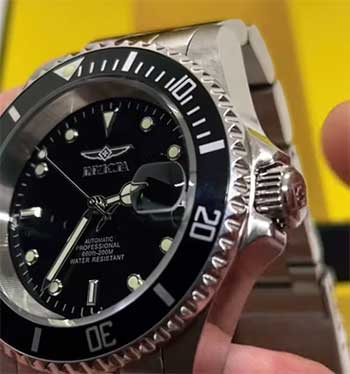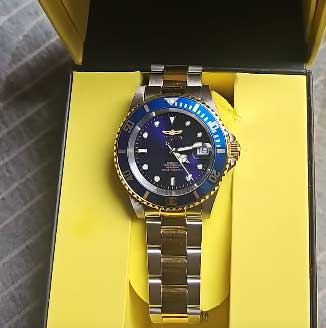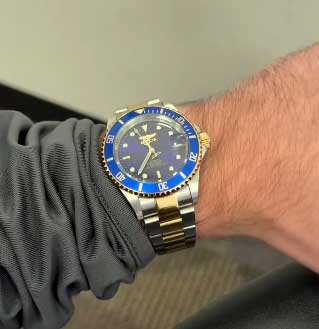I’ve always been fascinated by watches—those tiny, intricate machines that somehow manage to blend style, engineering, and history into something you can strap to your wrist. When I stumbled across Invicta watches, I was immediately intrigued.
Their bold designs, hefty builds, and surprisingly low price tags made me wonder: how can a watch that looks so impressive cost so little?
I mean, some Invicta models retail for under $100, while others that look like they could compete with luxury brands go for a few hundred bucks. What’s the catch?
After digging into the brand, its history, and the watchmaking world, I’ve pieced together the reasons why Invicta watches are so affordable. Let me walk you through it.
A Quick Look At Invicta’s Roots

To understand why Invicta watches are so cheap, it helps to know where the brand comes from.
Founded in 1837 in Switzerland by Raphael Picard, Invicta started as a maker of affordable, reliable timepieces.
The name “Invicta” means “invincible” in Latin, and the brand aimed to deliver sturdy, accessible watches.
Fast forward to today, and Invicta is now an American-owned company, with most of its production shifted to Asia.
This evolution sets the stage for why their watches are priced the way they are. It’s not just one factor—it’s a combination of smart business moves, manufacturing choices, and market positioning.
Reasons For Invicta Watches Being So Cheap
Here is a list of those reasons:
- Mass Production Keeps Costs Low
- Affordable Materials Make a Big Difference
- Strategic Manufacturing in Asia
- Bold Designs That Maximize Impact
- Direct-to-Consumer Sales and Discounts
- Brand Positioning: Affordable, Not Luxury
- Quality Control Trade-Offs
- The Power of Perception
Let’s talk about those reasons in detail:
- Mass Production Keeps Costs Low
One of the biggest reasons Invicta watches are so affordable is their reliance on mass production. I learned this the hard way when I started comparing watch brands. High-end watchmakers like Patek Philippe or Audemars Piguet produce limited runs of their timepieces, often hand-assembling each one.
That’s a costly process, and you pay for it—sometimes tens of thousands of dollars. Invicta, on the other hand, churns out thousands of watches using automated assembly lines. This approach slashes labor costs and allows them to produce watches at scale.
Think about it like this: if you’re making a sandwich at home, it’s going to cost you more time and money to craft one perfect artisanal sandwich than to make a dozen quick ones for a party. Invicta’s going for the party approach.
By producing large quantities, they can negotiate better deals on materials and streamline their operations, passing those savings on to you. It’s not about cutting corners—it’s about efficiency.
- Affordable Materials Make a Big Difference

Next up, let’s talk about materials.
When I first held an Invicta watch, I was impressed by its weight and shine.
It felt substantial, almost like a luxury watch.
But when I looked closer, I realized Invicta makes some clever material choices to keep costs down.
Instead of using precious metals like gold or platinum, they opt for stainless steel, which is durable, corrosion-resistant, and way cheaper. The crystals protecting the watch face?
Often it’s Flame Fusion, Invicta’s proprietary blend of mineral and sapphire crystal.
It’s not as scratch-resistant as pure sapphire (which you’ll find on pricier watches), but it’s tough enough for everyday wear and far less expensive.
Then there’s the movement—the heart of any watch. High-end brands often use in-house mechanical movements, which are meticulously crafted and expensive. Invicta, however, frequently uses off-the-shelf movements, like Japanese automatics from Seiko or Miyota, or reliable quartz movements.
These are solid, proven components, but they’re mass-produced and widely available, which keeps costs low. I’ll admit, when I learned this, I was a bit skeptical about quality, but these movements are workhorses. They get the job done without jacking up the price.
- Strategic Manufacturing in Asia
Here’s where things get interesting. Like many modern watch brands, Invicta has shifted much of its production to Asia, particularly China. I used to think “Made in China” meant low quality, but that’s an outdated stereotype.
Asia has become a hub for watch manufacturing because of lower labor costs and advanced facilities. By assembling their watches there, Invicta can keep prices down without sacrificing too much on quality control.
This move also lets Invicta tap into a global supply chain. Components like cases, dials, and straps are sourced from suppliers who specialize in high-volume production. It’s like shopping at a bulk store versus a boutique—same basic ingredients, but the bulk store’s prices are unbeatable.
For Invicta, this means they can offer a watch that looks and feels premium without the premium price tag.
- Bold Designs That Maximize Impact

One thing I love about Invicta watches is their in-your-face style.
Whether it’s the oversized Pro Diver or the chunky Speedway, these watches are designed to stand out.
But here’s the clever part: bold designs can mask cost-saving measures.
A large, intricate-looking dial or a hefty case can make a watch feel more expensive than it is.
Invicta leans into this, creating timepieces that scream “luxury” without the luxury price.
I noticed this when I compared an Invicta Pro Diver to a Rolex Submariner. At a glance, the Invicta’s chunky bezel and luminous markers give it a similar vibe, but the price difference is staggering—$100 versus $10,000.
Invicta’s designers are masters at creating visually striking watches that appeal to people who want that high-end look on a budget. It’s not about copying; it’s about capturing a vibe and making it accessible.
- Direct-to-Consumer Sales and Discounts
Another piece of the puzzle is how Invicta gets their watches to you. Unlike luxury brands that sell through exclusive boutiques or authorized dealers, Invicta often goes direct-to-consumer through online retailers, TV shopping networks, or their own website. Cutting out the middleman reduces overhead costs, which means lower prices for you.
I was blown away when I saw Invicta watches on sites like Amazon or Jomashop, often at steep discounts. This is no accident. Invicta frequently offers sales, bundles, or limited-time deals to move inventory quickly. It’s a high-volume, low-margin strategy that keeps their watches affordable.
Sure, it might make the brand feel less “exclusive,” but when you’re scoring a solid watch for under $200, exclusivity isn’t the point.
- Brand Positioning: Affordable, Not Luxury
Let’s be real: Invicta isn’t trying to compete with Rolex or Omega. Their goal is to offer stylish, reliable watches for the everyday person. This positioning is key to their low prices. Luxury brands invest heavily in prestige—think sponsored events, celebrity endorsements, and glossy ad campaigns.
That all gets baked into the price of their watches. Invicta skips most of that. They focus on delivering value, not status.
When I first started researching Invicta, I saw some online debates about whether they’re “real” watches or just fashion pieces.
Here’s my take: they’re real watches, just aimed at a different crowd. If you want a timepiece that looks good, keeps time, and doesn’t break the bank, Invicta’s got you covered. They’re not pretending to be heirlooms passed down for generations.
- Quality Control Trade-Offs
I’d be remiss if I didn’t mention quality control. Invicta’s affordability comes with some trade-offs. While most of their watches are reliable, I’ve read reviews (and experienced this myself with one purchase) where fit and finish weren’t perfect—maybe a misaligned bezel or a strap that felt a bit cheap.
Because they produce so many watches, inconsistencies can slip through. Luxury brands, with their smaller batches and rigorous inspections, rarely have these issues, but you’re paying for that perfection.
That said, Invicta’s quality is generally solid for the price. I’ve worn my Pro Diver for years, and it’s held up through daily wear, a few accidental knocks, and even some light swimming. If you’re not expecting flawless craftsmanship, the occasional quirk won’t ruin the experience.
- The Power of Perception
Finally, let’s talk about perception. Invicta’s low prices are partly psychological. By pricing their watches so affordably, they attract buyers who might otherwise skip watches altogether.
I fell into this trap myself—saw a flashy Invicta on sale, thought, “Why not?” and ended up with a watch I genuinely enjoy. Their pricing makes you feel like you’re getting a steal, which is a powerful draw. It’s not deceitful; it’s just smart marketing.
Frequently Asked Questions (FAQ)
Absolutely, if you’re looking for an affordable, stylish watch that gets the job done. I’ve found Invicta to be a great value for casual wear or as a starter watch for enthusiasts. They’re not investment pieces, but for the price, they offer solid performance and bold looks. Just know what you’re getting: a budget-friendly timepiece, not a luxury heirloom.
This one’s tricky. I own both, and each has its strengths. Seiko is known for its reliability, in-house movements, and understated designs. They’re often a step up in quality control and brand reputation, but they cost more. Invicta offers flashier styles and lower prices, making them ideal if you want a bold look on a budget. If durability and heritage matter most, go Seiko. If you want affordability and pizzazz, Invicta’s your pick.
Fossil and Invicta both target the affordable watch market, but they’re different beasts. Fossil leans heavily into fashion, with trendy designs and quartz movements. Invicta goes for bolder, often dive-inspired looks and includes automatic options. I’d say Invicta feels more “watch enthusiast” friendly, while Fossil is great for casual, style-driven buyers. It depends on whether you want a watch that screams personality (Invicta) or blends into your wardrobe (Fossil).
Are Invicta watches like Rolex?
Not really, but I get why people ask. Invicta’s Pro Diver series, for example, takes visual cues from Rolex’s Submariner, with similar bezels and markers. But the similarities end there. Rolex uses premium materials, in-house movements, and meticulous craftsmanship, justifying its high price. Invicta prioritizes affordability with mass-produced components. If you want a Rolex vibe without the Rolex price, Invicta’s a fun choice, but it’s not a substitute.
Wrapping It Up
So, why are Invicta watches so cheap? It’s a mix of mass production, affordable materials, strategic manufacturing, bold designs, direct sales, and a focus on value over prestige. They’re not perfect, but they don’t need to be.
Invicta delivers what it promises: eye-catching, reliable watches that won’t empty your wallet. As someone who’s worn their watches for years, I can say they’re a great way to dip your toes into the watch world without drowning in debt.
If you’re after a timepiece that’s fun, functional, and budget-friendly, Invicta’s hard to beat.
